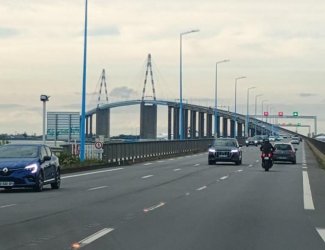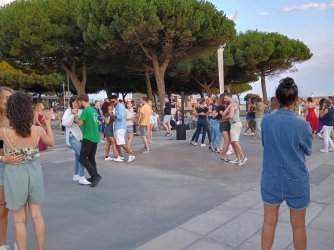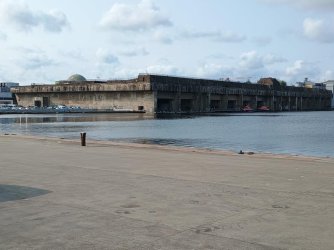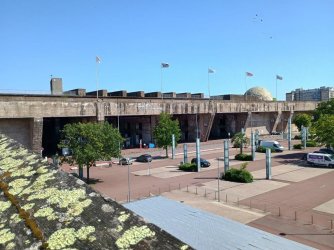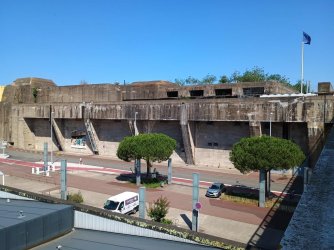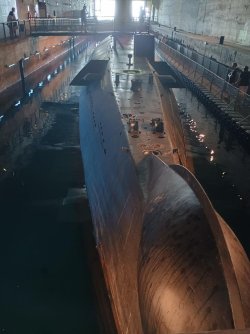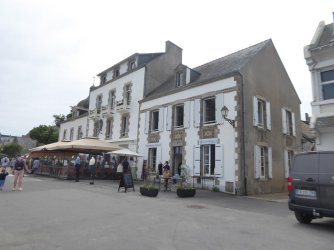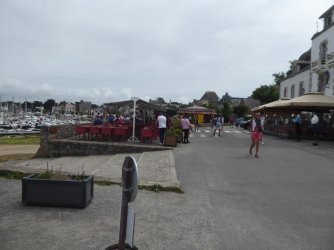- Joined
- Jun 24, 2008
- Posts
- 4,519
- Qantas
- Gold
- Virgin
- Red
le Musée Maritime de La Rochelle
As one of the largest sea ports in France, it is not surprising that La Rochelle has its own Maritime Museum. There are numerous displays as well as three vessels open for public inspection: France 1, a former meteorological ship (the ones that were stationed out in the Atlantic to report on weather patterns and systems), a retired tug and a former Atlantic trawler. All very interesting.
There are also two small yachts with historic significance:
Joshua

In 1968 the double-ended steel ketch Joshua was entered into the Golden Globe race, sponsored by the Sunday Times. This was the first single-handed, non-stop, round-the-world yacht race. Joshua was sailed by its owner Bernard Moitessier whom the maritime museum is named in honour of. A very interesting character, Bernard sailed Joshua to Plymouth to meet the criteria for the race and departed months after some of the smaller vessels. (Competitors were allowed to start any time between 1 June and 31 October.)
Moitessier made good time and reached Cape Horn in 77% of the time of Robin Knox-Johnston who, having departed England earlier, was leading the race. There was even speculation that Moitessier would not only win the 5,000 pound prize for the fastest circumnavigation, but also be the first to finish. There was talk of a naval escort to accompany him back to France and large celebrations to welcome him home. However, Moitessier was becoming increasingly disillusioned with the whole idea of the race and the over-commercialism of the modern world and after passing the Falkland Islands delivered a message to a passing freighter (by slingshot onto its deck) that he was withdrawing from the race.
So rather than continuing north and back to England, he turned to the east and passed by Capes Good Hope and Leeuwin a second time before continuing to Tahiti. In doing so he had been around the world single-handed, non-stop, one and a half times, travelling 37,455 km over a 10 month period. In some ways the race had become a farce: only one competitor finished, one committed suicide, one vessel sank and the remainder never finished.
You can read more about the race here.
Damien

In 1969, two young French guys set sail in Damien, a 10m yacht they had built themselves. Over the next 4 years they sailed 55,000 miles and travelled to both the Artic and Antarctic. Departing from La Rochelle, Damien sailed via London and Norway to Spitsbergen reaching 79 ° 36 ‘N. They then visited Iceland and Greenland before heading down the east coast of North America to the West Indies. Then followed a voyage of 2,000km up the Amazon.
From there they headed south and rounded Cape Horn from east to west. Then to South Georgia where Damien underwent repairs after being capsized three times in a storm. From there they sailed the 3,000 miles to Cape Town under jury rig for more extensive repairs before sailing to Crozet, Kerguelen, Heard and Macquarie Islands. Bad weather forced them north and they sailed to Tasmania, then New Caledonia, Fiji, Tonga, the Cook Islands and to Tahiti. From Tahiti they sailed directly to the Antarctic Peninsula and moored at Adelaide Island, being the first small sailing boat to moor under the Antarctic Circle.
From there back to La Rochelle via South Shetland, South Georgia, Argentina and Brazil. A classic voyage during times when there was no GPS and very few, if any, cruise ships visiting the Artic or the Antarctic.
As one of the largest sea ports in France, it is not surprising that La Rochelle has its own Maritime Museum. There are numerous displays as well as three vessels open for public inspection: France 1, a former meteorological ship (the ones that were stationed out in the Atlantic to report on weather patterns and systems), a retired tug and a former Atlantic trawler. All very interesting.
There are also two small yachts with historic significance:
Joshua

In 1968 the double-ended steel ketch Joshua was entered into the Golden Globe race, sponsored by the Sunday Times. This was the first single-handed, non-stop, round-the-world yacht race. Joshua was sailed by its owner Bernard Moitessier whom the maritime museum is named in honour of. A very interesting character, Bernard sailed Joshua to Plymouth to meet the criteria for the race and departed months after some of the smaller vessels. (Competitors were allowed to start any time between 1 June and 31 October.)
Moitessier made good time and reached Cape Horn in 77% of the time of Robin Knox-Johnston who, having departed England earlier, was leading the race. There was even speculation that Moitessier would not only win the 5,000 pound prize for the fastest circumnavigation, but also be the first to finish. There was talk of a naval escort to accompany him back to France and large celebrations to welcome him home. However, Moitessier was becoming increasingly disillusioned with the whole idea of the race and the over-commercialism of the modern world and after passing the Falkland Islands delivered a message to a passing freighter (by slingshot onto its deck) that he was withdrawing from the race.
So rather than continuing north and back to England, he turned to the east and passed by Capes Good Hope and Leeuwin a second time before continuing to Tahiti. In doing so he had been around the world single-handed, non-stop, one and a half times, travelling 37,455 km over a 10 month period. In some ways the race had become a farce: only one competitor finished, one committed suicide, one vessel sank and the remainder never finished.
You can read more about the race here.
Damien

In 1969, two young French guys set sail in Damien, a 10m yacht they had built themselves. Over the next 4 years they sailed 55,000 miles and travelled to both the Artic and Antarctic. Departing from La Rochelle, Damien sailed via London and Norway to Spitsbergen reaching 79 ° 36 ‘N. They then visited Iceland and Greenland before heading down the east coast of North America to the West Indies. Then followed a voyage of 2,000km up the Amazon.
From there they headed south and rounded Cape Horn from east to west. Then to South Georgia where Damien underwent repairs after being capsized three times in a storm. From there they sailed the 3,000 miles to Cape Town under jury rig for more extensive repairs before sailing to Crozet, Kerguelen, Heard and Macquarie Islands. Bad weather forced them north and they sailed to Tasmania, then New Caledonia, Fiji, Tonga, the Cook Islands and to Tahiti. From Tahiti they sailed directly to the Antarctic Peninsula and moored at Adelaide Island, being the first small sailing boat to moor under the Antarctic Circle.
From there back to La Rochelle via South Shetland, South Georgia, Argentina and Brazil. A classic voyage during times when there was no GPS and very few, if any, cruise ships visiting the Artic or the Antarctic.


























